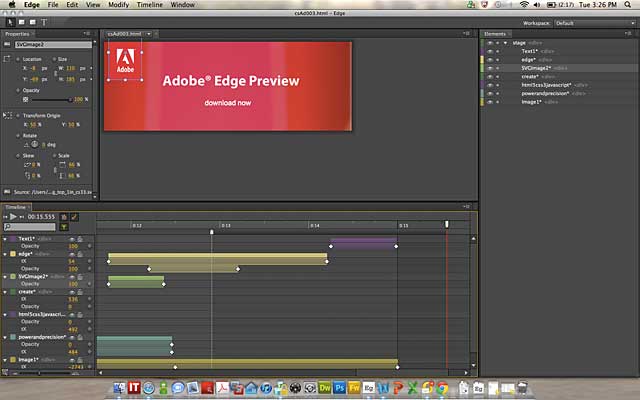Adobe's Edge is HTML5 at the Core
At Adobe MAX 2010, held in Los Angeles last October, Adobe showed a sneak preview of an HTML5 authoring tool. The company cautions that any of its sneak peeks may not see the light of day, but today the company launched a public preview of the authoring tool, now named Edge.
Adobe Edge uses a timeline interface, familiar to those who develop in Flash but also very familiar to those who create After Effects compositions, potentially bridging a gap between content creators and developers.
"Edge brings the time-line model familiar to many Flash authors to the new world of HTML5 and JavaScript," says Al Hilwa, IDC's program director for applications and development software, in an email just prior to the public preview release. "Serious designers can use it to build motion applications with some significant complexity, while HTML and JavaScript developers can use it to do more complex things simply."
At its core, Adobe Edge is based around WebKit, meaning that its flavor of HTML5 skews more toward Apple's Safari (iOS and Macintosh) and Google's Chrome than it does toward Mozilla-based or Microsoft's Internet Explorer 9 browsers. To that end, Adobe says its initial preview of Edge will allow use of certain, limited HTML5 commonalities, but will rely on jquery and an Adobe-specific JavaScript library to handle more complex requests.
For video-centric developers, the current public preview will allow for basic HTML5 skins or wrappers around a video, but will be limited in terms of interactivity and hot spots. Adobe says that it plans to implement interactivity in either a future public preview or an early release.
In addition, the product may eventually overlap Flash Catalyst and After Effects, in terms of what it is capable of doing with video assets, but Adobe sees it more akin to a marriage of the Flash interface and Dreamweaver-the latter being the only other Adobe product that allows a partial "roundtripping" of HTML content to and from Edge.
Adobe representatives would not speculate on either the fit of Edge into the overall Creative Suite package, which has as a hallmark the ability for content to roundtrip via dynamic libraries, or the pricing of Edge as a stand-alone application. Instead they focused on reasons for putting the product into the market for preview before it reached beta stage.
"Because of rapid changes around HTML5, the company is adopting an open development methodology for Adobe Edge," Adobe said in a press release. "We are releasing the software on the Adobe Labs site much earlier than normal in the development process - before it even reaches beta - in order to allow user feedback to help shape the final product."
This shaping of the final product is more akin to the days of Macromedia than it is of recent Adobe product releases, which rely on closed betas for feedback. Given the lack of HTML5 tools in the marketplace, however-and Adobe's reliance on selling tools as a large majority of its revenues-it's not a surprise that the company wants to get ahead of the HMTL5 tool trend.
"While in public preview," the company states, "Adobe Edge will be a no-charge download that web designers are encouraged to explore and provide feedback on, to help shape future preview releases."
Adobe Edge will remain in public preview at labs.adobe.com through the end of 2011, with the company saying it expects a 1.0 release within the first quarter of 2012.

Related Articles
Kevin Lynch shows off Flash—and HTML5 with CSS3—fueling Adobe's changing landscape.
25 Oct 2010